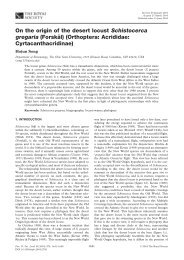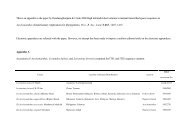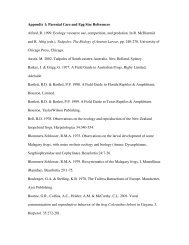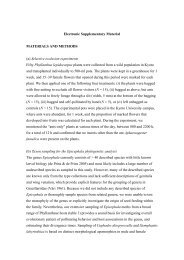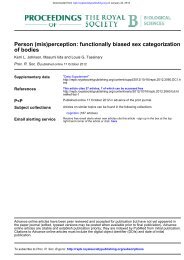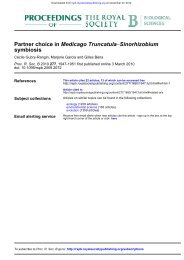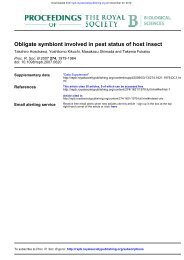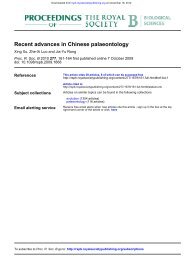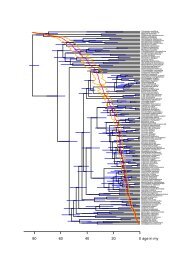Detailed supplementary methods of data gathering from ostriches
Detailed supplementary methods of data gathering from ostriches
Detailed supplementary methods of data gathering from ostriches
Create successful ePaper yourself
Turn your PDF publications into a flip-book with our unique Google optimized e-Paper software.
Page 1 – Electronic Supplementary Material – Wings & Sander: No gastric mill in sauropod dinosaurs<br />
ELECTRONIC SUPPLEMENTARY MATERIAL<br />
Journal: Proceedings <strong>of</strong> the Royal Society B: Biological Sciences<br />
Article: No gastric mill in sauropod dinosaurs: new evidence <strong>from</strong> analysis <strong>of</strong> gastrolith<br />
mass and function in <strong>ostriches</strong><br />
Authors: Oliver Wings & P. Martin Sander<br />
Supplementary Methods<br />
Relative gastrolith mass <strong>data</strong><br />
Ostriches<br />
To compare gastrolith mass to body mass, 347 stomachs <strong>of</strong> slaughtered <strong>ostriches</strong> <strong>of</strong> known<br />
weight were sampled <strong>from</strong> healthy free-ranging farm animals in Germany and South Africa.<br />
Samples <strong>from</strong> 135 German <strong>ostriches</strong> were collected between November 2000 and May 2003.<br />
Most were raised in large enclosures (total size: approximately 20 hectares) on the<br />
“Gemarkenh<strong>of</strong>” farm. Age (in months) and gender was recorded <strong>from</strong> all German birds. Body<br />
mass was measured for a few <strong>of</strong> the birds and later estimated to the nearest 5 kg by the farmer<br />
(R. Schumacher). In contrast, all South African birds were weighed shortly after death. The<br />
German and South African birds had ad libitum access to pebbles for swallowing throughout<br />
their lifetime, including the last days prior to their slaughter (pers. obs. OW, 2000-2003, and<br />
A. Olivier, pers. comm. 2003).<br />
South African birds were sampled because <strong>of</strong> their more natural habitat compared to<br />
that <strong>of</strong> the German specimens. Material was collected during slaughtering <strong>of</strong> <strong>ostriches</strong> in an<br />
abattoir <strong>of</strong> the Klein Karoo Co-operative in Oudtshoorn, Klein Karoo, between 31 st January<br />
2003 and 14 th February 2003. The birds originated <strong>from</strong> several farms in the Klein Karoo<br />
basin. A total number <strong>of</strong> 212 animals were sampled.
Page 2 – Electronic Supplementary Material – Wings & Sander: No gastric mill in sauropod dinosaurs<br />
Approximately 10% <strong>of</strong> the birds regurgitated stones (usually only small pebbles)<br />
during death throes (pers. obs. OW 2003). This was assisted by the inverted position <strong>of</strong> the<br />
birds on the abattoir conveyor line. Because the slaughtering process was rapid (usually more<br />
than one animal was processed each minute), it was not possible to collect the stomach<br />
contents with the same accuracy as in Germany. It is likely that some stones might have been<br />
lost during opening <strong>of</strong> the stomach as well as during transfer into the bucket. However, the<br />
maximum mass <strong>of</strong> the lost stones was visually estimated at
Page 3 – Electronic Supplementary Material – Wings & Sander: No gastric mill in sauropod dinosaurs<br />
Mexico Museum <strong>of</strong> Natural History (NMMNH 3690) was examined in 2002. However at this<br />
time some <strong>of</strong> the gastrolith specimens were on loan in Japan.<br />
For Caudipteryx, a mean gastrolith mass <strong>of</strong> 88 g was calculated based on a volume estimate <strong>of</strong><br />
the gastrolith clusters for all published specimens (for <strong>methods</strong> see Cheng et al. 2006). In<br />
combination with our estimate <strong>of</strong> Caudipteryx body mass as 7 kg, this results in a ratio <strong>of</strong><br />
1.25% <strong>of</strong> gastrolith mass to body mass.<br />
Taphonomic field work in Upper Jurassic sauropod quarries<br />
Methods<br />
We visited a number <strong>of</strong> documented gastrolith sites, including classic North American<br />
outcrops <strong>of</strong> Upper Jurassic and Lower Cretaceous strata, as well as other Jurassic sauropod<br />
localities world-wide. Additionally, we studied the taphonomy <strong>of</strong> numerous sauropod finds to<br />
assess potential associations <strong>of</strong> gastroliths and the possible reasons for their absence. Field<br />
work and first hand observations were conducted at many sites in the Morrison Formation,<br />
including the Carnegie Quarry in Dinosaur National Monument (Utah), Como Bluff and Bone<br />
Cabin Quarry (Wyoming), Dry Mesa Dinosaur Quarry (Utah), Howe Quarry (Wyoming), and<br />
Howe Stephens Quarry (Wyoming). These sites were complemented with Jurassic localities<br />
near Lourinhã in Portugal and in the Chubut region in Argentina.<br />
Fieldwork included the comparative study <strong>of</strong> sediments, the sauropod finds at these<br />
localities, their taphonomy, and the search for exotic stones in and around the quarries.<br />
Special focus was given to localities preserving articulated and well-associated sauropod<br />
skeletons. Furthermore, field localities and material <strong>of</strong> Cedarosaurus, Seismosaurus, and<br />
Dinheirosaurus holotypes (see above) were examined. The taphonomy <strong>of</strong> in situ sauropod<br />
skeletons at Dinosaur National Monument was studied regarding possible gastrolith loss. Data<br />
were recovered <strong>from</strong> the literature regarding the Tendaguru sauropod finds in Tanzania/Africa<br />
(Janensch 1929; Heinrich 1999). <strong>Detailed</strong> descriptions <strong>of</strong> the localities and their taphonomy
Page 4 – Electronic Supplementary Material – Wings & Sander: No gastric mill in sauropod dinosaurs<br />
are published elsewhere (Wings 2004).<br />
Visits to museum collections (American Museum <strong>of</strong> Natural History, New York City;<br />
College <strong>of</strong> Eastern Utah Prehistoric Museum, Price, Utah; Denver Museum <strong>of</strong> Natural<br />
History, Denver, Colorado; New Mexico Museum <strong>of</strong> Natural History, Albuquerque, New<br />
Mexico; Carnegie Museum <strong>of</strong> Natural History, Pittsburgh, Pennsylvania; Yale Peabody<br />
Museum, New Haven, Connecticut; Museum für Naturkunde, Humboldt University, Berlin,<br />
Germany; Staatliches Museum für Naturkunde Stuttgart, Germany; Sauriermuseum Aathal,<br />
Switzerland) complemented the field work to study gastrolith material and the general bone<br />
preservation <strong>from</strong> these and other sites such as Tendaguru. Historic field notes and<br />
publications about the quarries were also studied regarding the occurrence <strong>of</strong> gastroliths,<br />
sedimentology, taphonomy and faunal lists (Wings 2004).<br />
Results<br />
Our field work and collections visits indicate that overall occurrence <strong>of</strong> gastroliths in<br />
sauropods is extremely rare (Supplementary Table 2). Among the examined North American<br />
localities and specimens, there is conclusive evidence (gastroliths contained in fine-grained<br />
matrix without similar pebbles, direct association with bones, pebbles deposited as clusters)<br />
for genuine gastroliths only in two isolated skeletons: the holotypes <strong>of</strong> Seismosaurus and<br />
Cedarosaurus. Gastroliths were also found in one out <strong>of</strong> 15 Barosaurus skeletons <strong>from</strong> the<br />
Howe Quarry (Wyoming) (Michelis 2004). Most <strong>of</strong> the other sauropod quarries and isolated<br />
skeletons lacked any possible gastroliths. The greatest number <strong>of</strong> isolated putative gastroliths<br />
(about 600) was found in the Dry Mesa Quarry (Utah) which preserves the remains <strong>of</strong> at least<br />
20 sauropod individuals. On a world-wide scale, only about 2-4% <strong>of</strong> the sauropod finds have<br />
associated stones for which gastroliths are a plausible explanation (Wings 2004).
Page 5 – Electronic Supplementary Material – Wings & Sander: No gastric mill in sauropod dinosaurs<br />
Supplementary Tables<br />
Supplementary Table 1. Mean gastrolith mass vs. mean body mass in 27 species <strong>of</strong> living<br />
birds was compiled <strong>from</strong> own research (<strong>ostriches</strong>) and the ornithological literature. In several<br />
cases, mean values for body mass and gastrolith mass were calculated <strong>from</strong> different sources.<br />
Seasonal change in diet (e.g. summer: insects; winter: plant material) commonly occurs for<br />
several <strong>of</strong> the listed birds and complicates a correlation between diet and quantity <strong>of</strong><br />
gastroliths. However, note the correlation between high relative gastrolith mass and an<br />
herbivorous diet (predominately herbivorous species are marked in grey).<br />
Species Mean total<br />
gastrolith<br />
mass [g]<br />
Sample size<br />
(number <strong>of</strong><br />
individuals)<br />
Reference for<br />
gastroliths<br />
Mean body Reference for body Gastroliths in %<br />
mass [g]<br />
Corvus cornix (Dun Crow) 2.5 1738 (Rörig 1900) 493 (Rörig 1900) 0.5<br />
Corvus frugilegus (Rook) 3.2 918 (Rörig 1900) 480 (Rörig 1900) 0.7<br />
Corvus corone 3.3 62 (Rörig 1900) 510 (Rörig 1900) 0.7<br />
Garrulus glandarius (Jay) 1.2 - (Mangold 1927) 164 (Blotzheim 1993) 0.7<br />
Columba palumbus (Wood Pigeon) 4.9 - (Mangold 1927) 487 (Hoyo et al. 1997) 1<br />
Tetrao urogallus (Capercaillie) 25 - (Mangold 1927) 2975 (Hoyo et al. 1992) 0.8<br />
Tetrao tetrix (Black Grouse) 7.9 - (Mangold 1927) 1050 (Hoyo et al. 1992) 0.8<br />
Anthus pratensis (Meadow Pipit) 0.0089 79 (Walton 1984) 19.4 (Blotzheim 1985) 0.1<br />
Phasianus colchicus (Pheasant) 4.8 - (Mangold 1927) 1190 (Hoyo et al. 1992) 0.4<br />
Perdix perdix (Grey Partridge) 2.87 15 (Bialas et al. 1996) 383 (Hoyo et al. 1994) 0.8<br />
Coturnix coturnix (Quail) 0.2 - (Mangold 1927) 113 (Hoyo et al. 1994) 0.2<br />
Grus grus (Crane) 38 - (Mangold 1927) 5400 (Hoyo et al. 1996) 0.7<br />
Cygnus olor (Mute Swan) 69.8 7 (Owen & Cadbury 1975; 10800 (Hoyo et al. 1992) 0.7<br />
Thomas et al. 1977)<br />
Cygnus columbianus (Bewicks Swan) 28.5 13 (Owen & Cadbury 1975)5600 (Hoyo et al. 1992) 0.5<br />
Anas acuta (Pintail) 2.5 34 (Thomas et al. 1977) 850 (Hoyo et al. 1992) 0.3<br />
Anas crecca (Teal) 0.9 112 (Thomas et al. 1977) 350 (Hoyo et al. 1992) 0.3<br />
Anas platyrhynchos (Mallard) 3.8 113 (Thomas et al. 1977) 1163 (Hoyo et al. 1992) 0.3<br />
Anas strepera (Gadwall) 3.9 15 (Thomas et al. 1977) 920 (Hoyo et al. 1992) 0.4<br />
Anas penelope (Wigeon) 4.5 224 (Thomas et al. 1977) 693 (Hoyo et al. 1992) 0.7<br />
Anas clypeata (Shoveler) 1.6 44 (Thomas et al. 1977) 755 (Hoyo et al. 1992) 0.2<br />
Aythya ferina (Porchard) 2.9 9 (Thomas et al. 1977) 1000 (Hoyo et al. 1992) 0.3<br />
Aythya fuligula (Tufted Duck) 1.7 13 (Thomas et al. 1977) 1200 (Hoyo et al. 1992) 0.1<br />
mass<br />
<strong>of</strong> body mass
Page 6 – Electronic Supplementary Material – Wings & Sander: No gastric mill in sauropod dinosaurs<br />
Gallinula chloropus (Moorhen) 3.3 25 (Thomas et al. 1977) 314 (Blotzheim 1973) 1.1<br />
Fulica atra (Coot) 10.5 7 (Thomas et al. 1977) 835 (Blotzheim 1973) 1.3<br />
Numida meleagris (Helmeted Guinea-Fowl) 3.3 - (Ayeni et al. 1983) 1375 (Hoyo et al. 1994) 0.2<br />
Erithacus rubecula (European Robin) 0.067 88 (Herrera 1977) 17.2 (Herrera 1977) 0.4<br />
Struthio camelus (Ostrich) 930 347 (Wings 2004) 88900 (Wings 2004)<br />
1.1
Locality Stratigraphy Depositional<br />
environment<br />
Carnegie Quarry, Morrison Fm., Brushy River channels Coarse sandstone, in parts<br />
Dinosaur National Basin Member<br />
Monument<br />
conglomeratic<br />
Cleveland-Lloyd<br />
Dinosaur Quarry<br />
Como Bluff/Bone<br />
Cabin Quarry<br />
Page<br />
7 – Electronic Supplementary Material – Wings & Sander: No gastric mill in sauropod dinosaurs<br />
Supplementary Table 2. Summary <strong>of</strong> information for selected quarries. For references and discussion see Wings (2004).<br />
Morrison Fm., Brushy<br />
Basin Member<br />
Upper part <strong>of</strong> the<br />
Morrison Fm.<br />
Dry Mesa Quarry Morrison Fm., Brushy<br />
Basin Member<br />
Howe Quarry Morrison Fm. (145.7<br />
Ma)<br />
Cedarosaurus site Cedar Mountain Fm.,<br />
Yellow Cat Member<br />
Seismosaurus site Morrison Fm., Brushy<br />
Basin Member<br />
Water hole,<br />
oxbow lake<br />
Sedimentology Taphonomy Origin <strong>of</strong><br />
carcasses<br />
Carcasses washed together,<br />
articulated skeletons are<br />
abundant<br />
Allochthonous –<br />
parauthochtonous<br />
Mudstone Miring in mud Autochthonous 10000 disarticulated<br />
bones <strong>of</strong> at least 70<br />
individuals<br />
River channels Fine-grained sandstones and<br />
claystones<br />
Isolated skeletons and<br />
articulated skeletons washed<br />
together<br />
River channels Conglomeratic sandstones Bones washed together,<br />
mainly disarticulated<br />
skeletal elements<br />
Water hole,<br />
oxbow lake<br />
Floodplain with<br />
low water energy<br />
Allochthonous–<br />
parauthochtonous<br />
Amount <strong>of</strong> material General diversity Sauropod<br />
diversity<br />
No. <strong>of</strong><br />
sauropod<br />
individuals<br />
Some 5000 bones, 60 -High<br />
300 Dinosaurs<br />
4 genera >20 0<br />
Thousands <strong>of</strong> bones<br />
(only in BCQ approx.<br />
69 partial skeletons)<br />
Allochthonous More than 4000<br />
mainly isolated<br />
skeletal elements<br />
Siltstone, in parts sandy Miring in mud Autochthonous More than 4000 bones<br />
<strong>of</strong> at least 25 animals<br />
Mudstone Isolated skeleton resting on<br />
its belly<br />
River channels Sandstone Partly preserved isolated<br />
skeleton<br />
Medium 3 valid genera,<br />
maximum 6 genera<br />
10 2?<br />
High 5 genera Como Bluff:<br />
unknown<br />
Very high (highest<br />
in the Morrison<br />
Fm.)<br />
BCQ: 44<br />
No. <strong>of</strong><br />
gastroliths/<br />
exoliths<br />
Como: 0<br />
BCQ: 0<br />
5 genera >20 500-600<br />
Low 3 genera 25 64<br />
Parautochthonous -Isolated<br />
skeleton<br />
autochthonous<br />
Isolated find 1 genus 1 115<br />
Parautochthonous Isolated skeleton Isolated find 1 genus 1 >240
Page 8 – Electronic Supplementary Material – Wings & Sander: No gastric mill in sauropod dinosaurs<br />
SUPPLEMENTARY REFERENCES<br />
Ayeni, J., Olowo-Okorun, M. O. & Aire, T. A. 1983 The biology and utilization <strong>of</strong> helmet<br />
quinea-fowl (Numida meleagris galeata Pallas) in Nigeria. III Gizzard weights and<br />
contents. African Journal <strong>of</strong> Ecology 21, 11-18.<br />
Bialas, T., Hell, P. & Slamecka, J. 1996 Untersuchung von Magensteinen bei Fasanen und<br />
Rebhühnern. Zeitschrift für Jagdwissenschaft 42, 36-40.<br />
Blotzheim, U. N. G. v. 1973 Handbuch der Vögel Mitteleuropas. Frankfurt am Main:<br />
Akademische Verlagsgesellschaft.<br />
Blotzheim, U. N. G. v. 1985 Handbuch der Vögel Mitteleuropas. Wiesbaden: AULA-<br />
Verlag.<br />
Blotzheim, U. N. G. v. 1993 Handbuch der Vögel Mitteleuropas. Wiesbaden: AULA-<br />
Verlag.<br />
Cheng, L., Wings, O., Chen, X. & Sander, M. 2006 Gastroliths in the Triassic ichthyosaur<br />
Panjiangsaurus <strong>from</strong> China. Journal <strong>of</strong> Paleontology 80, 583-588.<br />
Gillette, D. D. 1994 Seismosaurus, the Earth Shaker. New York: Columbia University<br />
Press.<br />
Heinrich, W.-D. 1999 The taphonomy <strong>of</strong> dinosaurs <strong>from</strong> the Upper Jurassic <strong>of</strong> Tendaguru,<br />
Tanzania (East Africa), based on field sketches <strong>of</strong> the German Tendaguru<br />
expedition (1909-1913). Mitteilungen aus dem Museum für Naturkunde in Berlin,<br />
Geowissenschaftliche Reihe 2, 25 -61.<br />
Herrera, C. M. 1977 Ecologia alimentacia del Petirrijo (Erithacus rubecula) durante su<br />
invernada en encinares del Sur de Espana. Doñana, Acta Vertebrata 4, 35-59.
Page 9 – Electronic Supplementary Material – Wings & Sander: No gastric mill in sauropod dinosaurs<br />
Hoyo, J. d., Elliott, A. & Sargatal, J. 1992 Handbook <strong>of</strong> the Birds <strong>of</strong> the World. Barcelona:<br />
Lynx Editions.<br />
Hoyo, J. d., Elliott, A. & Sargatal, J. 1994 Handbook <strong>of</strong> the Birds <strong>of</strong> the World. Barcelona:<br />
Lynx Editions.<br />
Hoyo, J. d., Elliott, A. & Sargatal, J. 1996 Handbook <strong>of</strong> the Birds <strong>of</strong> the World. Barcelona:<br />
Lynx Editions.<br />
Hoyo, J. d., Elliott, A. & Sargatal, J. 1997 Handbook <strong>of</strong> the Birds <strong>of</strong> the World. Barcelona:<br />
Lynx Editions.<br />
Janensch, W. 1929 Magensteine bei Sauropoden der Tendaguru-Schichten.<br />
Palaeontographica, Supplement VII, 135-144.<br />
Mangold, E. 1927 Die Bedeutung von Steinchen und Sand im Hühnermagen. Archiv für<br />
Geflügelkunde 1, 145-152.<br />
Michelis, I. 2004 Vergleichende Taphonomie des Howe Quarry's (Morrison Formation,<br />
Oberer Jura), Bighorn County, Wyoming, USA. Published Ph.D. Thesis, pp. 324.<br />
Bonn: University <strong>of</strong> Bonn. (Accessible online at http://nbn-<br />
resolving.de/urn:nbn:de:hbz:5N-04632)<br />
Owen, M. & Cadbury, C. J. 1975 The ecology and mortality <strong>of</strong> swans at the Ouse Washes,<br />
England. Wildfowl 26, 31-42.<br />
Rörig, G. 1900 Die Krähen Deutschlands in ihrer Bedeutung für Land- und<br />
Forstwirthschaft. Arbeiten aus der Biologischen Abtheilung für Land- und<br />
Forstwirthschaft am Kaiserlichen Gesundheitsamte 1, 285-400.<br />
Thomas, G. J., Owen, M. & Richards, P. 1977 Grit in waterfowl at the Ouse Washes,<br />
England. Wildfowl 28, 136-138.
Page 10 – Electronic Supplementary Material – Wings & Sander: No gastric mill in sauropod dinosaurs<br />
Walton, K. C. 1984 Stomach stones in meadow pipits Anthus pratensis. Bird Study 31, 39-<br />
42.<br />
Wings, O. 2004 Identification, Distribution, and Function <strong>of</strong> Gastroliths in Dinosaurs and<br />
Extant Birds with Emphasis on Ostriches (Struthio camelus). Published Ph.D.<br />
Thesis, pp. 187. Bonn: University <strong>of</strong> Bonn. (Accessible online at http://nbn-<br />
resolving.de/urn:nbn:de:hbz:5N-04626)



